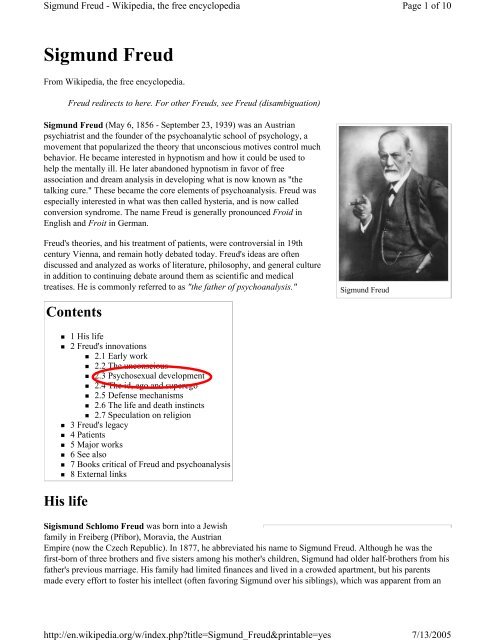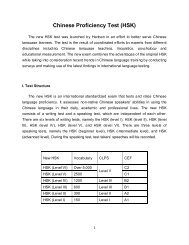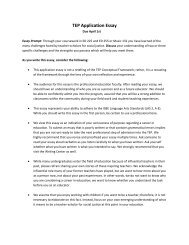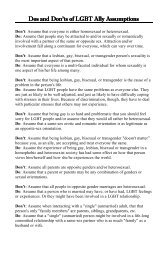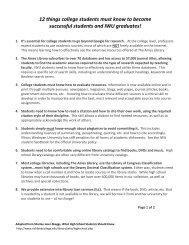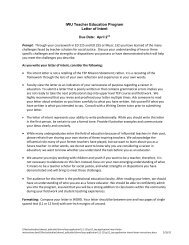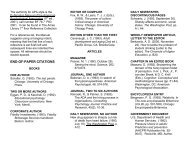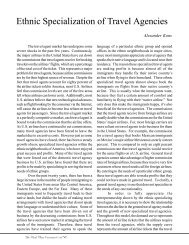You also want an ePaper? Increase the reach of your titles
YUMPU automatically turns print PDFs into web optimized ePapers that Google loves.
<strong>Sigmund</strong> <strong>Freud</strong> - Wikipedia, the free encyclopedia<br />
<strong>Sigmund</strong> <strong>Freud</strong><br />
From Wikipedia, the free encyclopedia.<br />
<strong>Freud</strong> redirects to here. For other <strong>Freud</strong>s, see <strong>Freud</strong> (disambiguation)<br />
<strong>Sigmund</strong> <strong>Freud</strong> (May 6, 1856 - September 23, 1939) was an Austrian<br />
psychiatrist and the founder of the psychoanalytic school of psychology, a<br />
movement that popularized the theory that unconscious motives control much<br />
behavior. He became interested in hypnotism and how it could be used to<br />
help the mentally ill. He later abandoned hypnotism in favor of free<br />
association and dream analysis in developing what is now known as "the<br />
talking cure." These became the core elements of psychoanalysis. <strong>Freud</strong> was<br />
especially interested in what was then called hysteria, and is now called<br />
conversion syndrome. The name <strong>Freud</strong> is generally pronounced Froid in<br />
English and Froit in German.<br />
<strong>Freud</strong>'s theories, and his treatment of patients, were controversial in 19th<br />
century Vienna, and remain hotly debated today. <strong>Freud</strong>'s ideas are often<br />
discussed and analyzed as works of literature, philosophy, and general culture<br />
in addition to continuing debate around them as scientific and medical<br />
treatises. He is commonly referred to as "the father of psychoanalysis."<br />
Contents<br />
� 1 His life<br />
� 2 <strong>Freud</strong>'s innovations<br />
� 2.1 Early work<br />
� 2.2 The unconscious<br />
� 2.3 Psychosexual development<br />
� 2.4 The id, ego and superego<br />
� 2.5 Defense mechanisms<br />
� 2.6 The life and death instincts<br />
� 2.7 Speculation on religion<br />
� 3 <strong>Freud</strong>'s legacy<br />
� 4 Patients<br />
� 5 Major works<br />
� 6 See also<br />
� 7 Books critical of <strong>Freud</strong> and psychoanalysis<br />
� 8 External links<br />
His life<br />
<strong>Sigmund</strong> <strong>Freud</strong><br />
Page 1 of 10<br />
Sigismund Schlomo <strong>Freud</strong> was born into a Jewish<br />
family in Freiberg (Příbor), Moravia, the Austrian<br />
Empire (now the Czech Republic). In 1877, he abbreviated his name to <strong>Sigmund</strong> <strong>Freud</strong>. Although he was the<br />
first-born of three brothers and five sisters among his mother's children, <strong>Sigmund</strong> had older half-brothers from his<br />
father's previous marriage. His family had limited finances and lived in a crowded apartment, but his parents<br />
made every effort to foster his intellect (often favoring <strong>Sigmund</strong> over his siblings), which was apparent from an<br />
http://en.wikipedia.org/w/index.php?title=<strong>Sigmund</strong>_<strong>Freud</strong>&printable=yes<br />
7/13/2005
<strong>Sigmund</strong> <strong>Freud</strong> - Wikipedia, the free encyclopedia<br />
early age. <strong>Sigmund</strong> was ranked first in his class in 6 of 8<br />
years of schooling. He went on to attend the University<br />
of Vienna at 17, in 1873-1881.<br />
In his 40's, <strong>Freud</strong> "had numerous psychosomatic<br />
disorders as well as exaggerated fears of dying and other<br />
phobias" (Corey 2001, p. 67). During this time <strong>Freud</strong><br />
was involved in the task of self-analysis. He explored his<br />
own dreams, childhood memories, and the dynamics of<br />
his personality development. During this self-analysis, he<br />
came to realize the hostility he felt towards his father<br />
(Jacob <strong>Freud</strong>), and "he also recalled his childhood sexual<br />
feelings for his mother (Amalia <strong>Freud</strong>), who was<br />
attractive, warm, and protective" (Corey 2001, p. 67).<br />
Corey (2001) considers this time of emotional difficulty<br />
to be the most creative time in <strong>Freud</strong>'s life.<br />
Overall, little is known of <strong>Freud</strong>'s early life as he<br />
destroyed his personal papers at least twice, once in 1885<br />
and again in 1907. Additionally, his later papers were<br />
closely guarded in the <strong>Sigmund</strong> <strong>Freud</strong> Archives and only<br />
available to Ernest Jones, his official biographer, and a<br />
few other members of the inner circle of psychoanalysis.<br />
The work of Jeffrey Moussaieff Masson shed some light<br />
on the nature of the suppressed material. <strong>Freud</strong> had little<br />
tolerance for colleagues who diverged from his<br />
psychoanalytic doctrines. For example, he attempted to<br />
expel those who disagreed with the movement (Corey, 2001).<br />
Following the Nazi German Anschluss, with the financial help of his patient and friend Princess Marie Bonaparte,<br />
<strong>Freud</strong> fled Austria with his family. On June 4th, 1938 they were allowed across the border into France and then<br />
they traveled from Paris to Hampstead, London, England, where they lived at 20 Maresfield Gardens, now the<br />
<strong>Freud</strong> Museum. As he was leaving Germany, <strong>Freud</strong> was asked to sign a statement that he had been treated<br />
respectfully by the Nazis. An oft-repeated story claims <strong>Freud</strong> complied, but then added at the bottom the sarcastic<br />
note: "I can heartily recommend the Gestapo to anyone." The actual document contains no such comment.<br />
<strong>Freud</strong>'s daughter Anna <strong>Freud</strong> was also a distinguished psychologist, particularly in the fields of child and<br />
developmental psychology. <strong>Sigmund</strong> is the grandfather of painter Lucian <strong>Freud</strong> and comedian and writer Clement<br />
<strong>Freud</strong>, and the great-grandfather of journalist Emma <strong>Freud</strong>, and fashion designer Bella <strong>Freud</strong>.<br />
<strong>Sigmund</strong> <strong>Freud</strong> was also both a blood uncle and an uncle-in-law to public relations and propaganda wizard<br />
Edward Bernays. Bernays's mother, Anna <strong>Freud</strong> Bernays, was sister to <strong>Sigmund</strong>. Bernays's father, Ely Bernays,<br />
was brother to <strong>Sigmund</strong>'s wife, Martha Bernays <strong>Freud</strong>.<br />
<strong>Freud</strong> was a smoker of Churchill-style cigars for most of his life; even after having his jaw removed due to<br />
malignancy, he continued to smoke until his death in 1939. It is said that he would smoke an entire box of cigars<br />
daily.<br />
<strong>Freud</strong>'s innovations<br />
Page 2 of 10<br />
Memorial plaque of <strong>Sigmund</strong> <strong>Freud</strong> at his birthplace in<br />
Pribor (Příbor), The Czech Republic.<br />
<strong>Freud</strong> has been influential in two related, but distinct ways. He simultaneously developed a theory of the human<br />
http://en.wikipedia.org/w/index.php?title=<strong>Sigmund</strong>_<strong>Freud</strong>&printable=yes<br />
7/13/2005
<strong>Sigmund</strong> <strong>Freud</strong> - Wikipedia, the free encyclopedia<br />
mind and human behavior, and clinical techniques for attempting to help neurotics.<br />
Early work<br />
A lesser known interest of <strong>Freud</strong>'s was neurology. He was an early researcher on the topic of cerebral palsy, then<br />
known as "cerebral paralysis". He published several medical papers on the topic. He also showed that the disease<br />
existed far before other researchers in his day began to notice and study it. He also suggested that William Little,<br />
the man who first identified cerebral palsy, was wrong about lack of oxygen during the birth process being a<br />
cause. Instead, he suggested that complications in birth were only a symptom of the problem. It was not until the<br />
1980s when his speculations were confirmed by more modern research.<br />
<strong>Freud</strong> was an early user and proponent of cocaine (see <strong>Freud</strong> and Cocaine<br />
(http://www.historyhouse.com/in_history/cocaine/)). He wrote several articles on the antidepressant qualities of<br />
the drug, and he was influenced by his friend and confident, Wilhelm Fleiss, who recommended cocaine for the<br />
treatment of the "nasal reflex neurosis." Fleiss operated on <strong>Freud</strong> and a number of <strong>Freud</strong>'s patients whom he<br />
believed to be suffering from the disorder. Emma Eckstein underwent disastrous nasal surgery by Fleiss.<br />
<strong>Freud</strong> hoped that his research would provide a solid scientific basis for his therapeutic technique. The goal of<br />
<strong>Freud</strong>ian therapy, or psychoanalysis, was to bring to consciousness repressed thoughts and feelings, in order to<br />
allow the patient to develop a stronger ego. Classically, the bringing of unconscious thoughts and feelings to<br />
consciousness is brought about by encouraging the patient to talk in "free-association" and to talk about dreams.<br />
Another important element of psychoanalysis is a relative lack of direct involvement on the part of the analyst,<br />
which is meant to encourage the patient to project thoughts and feelings onto the analyst. Through this process,<br />
called "transference," the patient can reenact and resolve repressed conflicts, especially childhood conflicts with<br />
(or about) parents.<br />
The unconscious<br />
The interpretation of dreams - a<br />
powerful early work of <strong>Freud</strong><br />
Page 3 of 10<br />
Perhaps the most significant contribution <strong>Freud</strong> has made to modern<br />
thought is his conception of the unconscious. During the 19th century the<br />
dominant trend in Western thought was positivism, the claim that people<br />
could accumulate real knowledge about themselves and their world, and<br />
exercise rational control over both. <strong>Freud</strong>, however, suggested that these<br />
claims were in fact delusions; that we are not entirely aware of what we<br />
even think, and often act for reasons that have nothing to do with our<br />
conscious thoughts. The concept of the unconscious was groundbreaking<br />
in that he proposed that awareness existed in layers and there were<br />
thoughts occurring "below the surface." Dreams, called the "royal road to<br />
the unconscious", provided the best examples of our unconscious life,<br />
and in The Interpretation of Dreams <strong>Freud</strong> both developed the argument<br />
that the unconscious exists, and described a method for gaining access to<br />
it. The Preconscious was described as a layer between conscious and<br />
unconscious thought—that which we could access with a little effort.<br />
Crucial to the operation of the unconscious is "repression." According to<br />
<strong>Freud</strong>, people often experience thoughts and feelings that are so painful<br />
that people cannot bear them. Such thoughts and feelings—and<br />
associated memories—could not, <strong>Freud</strong> argued, be banished from the<br />
mind, but could be banished from consciousness. Thus they come to<br />
constitute the unconscious. Although <strong>Freud</strong> later attempted to find<br />
http://en.wikipedia.org/w/index.php?title=<strong>Sigmund</strong>_<strong>Freud</strong>&printable=yes<br />
7/13/2005
<strong>Sigmund</strong> <strong>Freud</strong> - Wikipedia, the free encyclopedia<br />
patterns of repression among his patients in order to derive a general model of the mind, he also observed that<br />
individual patients repress different things. Moreover, <strong>Freud</strong> observed that the process of repression is itself a<br />
non-conscious act (in other words, it did not occur through people willing away certain thoughts or feelings).<br />
<strong>Freud</strong> supposed that what people repressed was in part determined by their unconscious. In other words, the<br />
unconscious was for <strong>Freud</strong> both a cause and effect of repression.<br />
Psychosexual development<br />
Main article: Psychosexual development<br />
<strong>Freud</strong> also believed that the libido developed in individuals by changing<br />
its object. He argued that humans are born "polymorphously perverse,"<br />
meaning that any number of objects could be a source of pleasure. He<br />
further argued that, as humans developed, they fixated on different and<br />
specific objects through their stages of development—first in the oral<br />
stage (exemplified by an infant's pleasure in nursing), then in the anal<br />
stage (exemplified by a toddler's pleasure in controlling his or her<br />
bowels), then in the phallic stage. <strong>Freud</strong> argued that children then passed<br />
through a stage where they fixated on the parent of the opposite sex and<br />
thought the same-sexed parent a rival. <strong>Freud</strong> named his new theory the<br />
Oedipus Complex after the famous Greek tragedy by Sophocles.“I found<br />
in myself a constant love for my mother, and jealousy of my father. I now<br />
consider this to be a universal event in childhood” <strong>Freud</strong> said. <strong>Freud</strong><br />
sought to anchor this pattern of development in the dynamics of the mind.<br />
Each stage is a progression into adult sexual maturity, characterized by a<br />
strong ego and the ability to delay gratification. (see Three Essays on the<br />
Theory of Sexuality.) It also seems that <strong>Freud</strong> believed that the<br />
manipulation of the genitals and the sexual desires are something that<br />
undermines the human as oneself. Surrendering to his sexual desires<br />
would mean the unconscious as the triumphant mind.<br />
<strong>Freud</strong> hoped to prove that his model was universally valid. He thus turned to ancient mythology and<br />
contemporary ethnography for comparative material. <strong>Freud</strong> used the Greek tragedy by Sophocles Oedipus Rex to<br />
point out how much he believed that people (young boys in particular) desire incest, and must repress that desire.<br />
The Oedipus conflict was described as a state of psychosexual development and awareness. He also turned to<br />
anthropological studies of totemism and argued that totemism reflected a ritualized enactment of a tribal Oedipal<br />
conflict.<br />
No discussion of <strong>Sigmund</strong> <strong>Freud</strong> is complete without some mention of his highly influential views on the role and<br />
psychology of women; views which set the progress of women in Western culture back decades. Believing as he<br />
did that women were a kind of mutilated male, who must learn to accept her deformity (the lack of a penis) and<br />
submit to some imagined biological imperative, he contributed a great deal to the vocabulary of mysogyny - terms<br />
such as penis envy, and castrating (both used to describe women who attempted to excel in any field outside the<br />
home) were used to discourage women from obtaining education or entering any field dominated by men, until<br />
the 1970s. It is also rumored that he developed some of his theories about the sexual fantasies of children toward<br />
their parents to cover up at least one case misconduct by an adult colleague of his toward one of his patients<br />
(Dora). <strong>Freud</strong>'s views on women's equality still have an unfortunate effect on the status of women in the<br />
professions.<br />
The id, ego and superego<br />
http://en.wikipedia.org/w/index.php?title=<strong>Sigmund</strong>_<strong>Freud</strong>&printable=yes<br />
Page 4 of 10<br />
What's on a man's mind – <strong>Sigmund</strong><br />
<strong>Freud</strong><br />
7/13/2005
<strong>Sigmund</strong> <strong>Freud</strong> - Wikipedia, the free encyclopedia<br />
<strong>Freud</strong> sought to explain how the unconscious operates by proposing that it has a particular structure. He proposed<br />
that the unconscious was divided into three parts: Id, Ego, and Superego. The Id (Latin, = "it" = es in the original<br />
German) represented primary process thinking — our most primitive need gratification type thoughts. The<br />
Superego (überich in German) represented our conscience and counteracted the Id with moral and ethical<br />
thoughts. <strong>Freud</strong> based the term Id on the work of Georg Groddeck. The Ego (ich) stands in between both to<br />
balance our primitive needs and our moral/ethical beliefs. A healthy ego provides the ability to adapt to reality<br />
and interact with the outside world in a way that accommodates both Id and Superego. The general claim that the<br />
mind is not a monolithic or homogeneous thing continues to have an enormous influence on people outside of<br />
psychology.<br />
<strong>Freud</strong> was especially concerned with the dynamic relationship between these three parts of the mind. <strong>Freud</strong><br />
argued that the dynamic is driven by innate drives. But he also argued that the dynamic changes in the context of<br />
changing social relationships.<br />
Defense mechanisms<br />
According to <strong>Freud</strong>, the defense mechanisms are the method by<br />
which the ego can solve the conflicts between the superego and<br />
the id. The use of the mechanisms required eros, and they are<br />
helpful if moderately used. The use of defense mechanisms, may<br />
attenuate the conflict between the id and superego, but their<br />
overuse or reuse rather than confrontation can lead to either<br />
anxiety or guilt which may result in psychological disorders such<br />
as depression. His daughter, Anna <strong>Freud</strong>, had done the most<br />
significant work on this field, yet credited <strong>Sigmund</strong> with Defense<br />
Mechanisms as he began the work. The defense mechanisms<br />
include, denial, reaction formation, displacement,<br />
repression/suppression (the proper term), projection,<br />
intellectualisation, rationalisation, compensation, sublimation<br />
and regressive emotionality.<br />
� Denial means that someone will not (deliberately) admit to<br />
the truth. For example, a student may have received a bad<br />
grade on a report card but tells himself that grades don't<br />
matter.<br />
� Repression occurs when someone cannot remember a past<br />
traumatic experience, while suppression is a conscious<br />
effort to do the same.<br />
Page 5 of 10<br />
<strong>Sigmund</strong> and Anna <strong>Freud</strong> 1913 on a holiday in<br />
the Dolomits<br />
� Intellectualisation involves removing one's self, emotionally, from a stressful event. Intellectualisation is<br />
often accomplished through rationalisation rather than accepting reality, one may explain it away to<br />
remove one's self.<br />
� Compensation occurs when someone takes up one behavior because one cannot accomplish another<br />
behavior. For example, the second born child may clown around to get attention since the older child is<br />
already an accomplished scholar.<br />
� Sublimation is the channeling of impulses to socially accepted behaviours. For instance, the use of a dark,<br />
gloomy poem to describe life by such poets as Emily Dickinson.<br />
� Reaction formation takes place when someone takes the opposite approach consciously compared to what<br />
he wants unconsciously. For example, someone may engage in violence against another race because, he<br />
http://en.wikipedia.org/w/index.php?title=<strong>Sigmund</strong>_<strong>Freud</strong>&printable=yes<br />
7/13/2005
Erikson's stages of psychosocial development - Wikipedia, the free encyclopedia<br />
Erikson's stages of psychosocial development<br />
From Wikipedia, the free encyclopedia.<br />
Erikson's stages of psychosocial development were developed by Erik Erikson, and describe eight<br />
developmental stages through which a healthily developing human should pass from infancy to late adulthood. In<br />
each stage the person confronts, and hopefully masters, new challenges. Each stage builds on the successful<br />
completion of earlier stages. The challenges of stages not successfully completed may be expected to reappear as<br />
problems in the future.<br />
Age<br />
Psychosocial<br />
crisis<br />
Significant<br />
relations<br />
0-1, Infant trust vs mistrust mother<br />
2-3, Toddler<br />
autonomy vs<br />
shame and<br />
doubt<br />
initiative vs<br />
guilt<br />
parents<br />
Psychosocial<br />
modalities<br />
to get, to give in<br />
return<br />
to hold on, to let<br />
go<br />
Psychosocial<br />
virtues<br />
Maladaptations/malignancies<br />
hope, faith sensory distortion, withdrawal<br />
will,<br />
determination<br />
impulsivity, compulsion<br />
3-6,<br />
Preschooler<br />
family<br />
to go after, to<br />
play<br />
purpose,<br />
courage<br />
ruthlessness, inhibition<br />
7-12, School- industry vs<br />
age child inferiority<br />
neighborhood<br />
and school<br />
to complete, to<br />
make things<br />
together<br />
competence narrow virtuosity, inertia<br />
12-18,<br />
Adolescent<br />
ego-identity vs peer groups,<br />
role-confusion role models<br />
to be oneself, to<br />
share oneself<br />
fidelity,<br />
loyalty<br />
fanaticism, repudiation<br />
20-45,<br />
Young adult<br />
intimacy vs<br />
isolation<br />
partners,<br />
friends<br />
to lose and find<br />
love<br />
oneself in another<br />
promiscuity, exclusivity<br />
30-65,<br />
Middle aged<br />
adult<br />
generativity vs<br />
self-absorption<br />
household, coworkers<br />
to make actual, to<br />
care<br />
take care of<br />
overextension, rejectivity<br />
50+, Old<br />
adult<br />
integrity vs<br />
despair<br />
mankind or<br />
'my kind'<br />
to be, through<br />
having been, to<br />
face not being<br />
wisdom presumption despair<br />
Retrieved from "http://en.wikipedia.org/wiki/Erikson%27s_stages_of_psychosocial_development"<br />
Categories: Human development | Social philosophy<br />
� This page was last modified 06:05, 10 May 2005.<br />
� All text is available under the terms of the GNU Free<br />
Documentation License (see Copyrights for details).<br />
http://en.wikipedia.org/w/index.php?title=Erikson%27s_stages_of_psychosocial_develop...<br />
Page 1 of 1<br />
7/13/2005
Kohlberg's stages of moral development - Wikipedia, the free encyclopedia<br />
Kohlberg's stages of moral development<br />
From Wikipedia, the free encyclopedia.<br />
Kohlberg's stages of moral development were developed by Lawrence Kohlberg to explain the development of<br />
moral reasoning. This theory holds that moral reasoning, which Kohlberg thought to be the basis for ethical<br />
behavior, has developmental stages. From the results of his studies at Harvard's Center for Moral Education with<br />
colleague Sandy Roney-Hays, Kohlberg concluded that there are six identifiable stages of moral development.<br />
These stages can be classified into three levels. Note that these stages are known by various names.<br />
Contents<br />
� 1 Stages<br />
� 2 An explanation of the stages<br />
� 2.1 Pre-Conventional<br />
� 2.2 Conventional<br />
� 2.3 Post-Conventional<br />
� 2.4 Other<br />
� 3 Examples<br />
� 4 Theoretical assumptions<br />
� 5 Criticism<br />
Stages<br />
Level 1 (Pre-conventional)<br />
1. Obedience and punishment orientation<br />
2. Self-interest orientation<br />
Level 2 (Conventional)<br />
3. Interpersonal accord and conformity (The good boy/good girl attitude)<br />
4. Authority and social-order maintaining orientation (Law and order morality)<br />
Level 3 (Post-conventional)<br />
5. Social contract orientation<br />
6. Universal ethical principles (Principled conscience)<br />
An explanation of the stages<br />
Pre-Conventional<br />
The pre-conventional level of moral reasoning is especially common in children, although adults can also exhibit<br />
this level of reasoning. Reasoners in the pre-conventional level judge the morality of an action by its direct<br />
consequences. The pre-conventional level is divided into two stages: stage one (obedience and punishment<br />
orientation); stage two (self-interest orientation).<br />
In stage one, individuals focus on the direct consequences that their actions will have for themselves. For<br />
http://en.wikipedia.org/w/index.php?title=Kohlberg%27s_stages_of_moral_development&...<br />
Page 1 of 4<br />
7/13/2005
Kohlberg's stages of moral development - Wikipedia, the free encyclopedia<br />
example, they think that an action is morally wrong if the person who commits it gets punished.<br />
Stage two espouses the what's in it for me position; right behavior being defined by what is in one's own best<br />
interest. Stage two reasoning shows a limited interest in the needs of others, but only to a point where it might<br />
furthers one's own interests, such as "you scratch my back, and I'll scratch yours." Concern for others is not based<br />
on loyalty or intrinsic respect in stage two.<br />
Conventional<br />
The conventional level of moral reasoning is typical of adults and older children. Persons who reason in a<br />
conventional way judge the morality of actions by comparing these actions to social rules and expectations.<br />
The conventional level is divided into two stages: stage three (conformity orientation); stage four (law-and-order<br />
morality).<br />
Individuals whose moral reasoning is in stage three seek approval from other people. They try to be a good boy or<br />
good girl having learned that there is inherent value in doing so. Stage three reasoning may judge the morality of<br />
an action by evaluating its consequences in terms of a person's relationships.<br />
Stage four, individuals think it is important to obey the laws and social conventions because of its importance to<br />
maintaining society. Moral reasoning in stage four is thus beyond the need for approval exhibited in stage three.<br />
Post-Conventional<br />
The post-conventional level is divided into two stages: stage five (social contract orientation); stage six<br />
(principled conscience).<br />
Persons in stage five have certain principles to which they may attach more value than laws, such as human rights<br />
or social justice. In this reasoning, actions are wrong if they violate these ethical principles. Laws are regarded as<br />
social contracts rather than dictums, and must be changed when necessary (provided there is agreement). By this<br />
reasoning laws that do not promote general social welfare, for example, should be changed. (Democratic<br />
governments are ostensibly based on stage five reasoning.)<br />
In stage six, the final stage, moral reasoning is based on the use of abstract reasoning using universal ethical<br />
principles. While Kohlberg insisted that stage six exists, he had difficulty finding participants who use it. It<br />
appears that people rarely if ever reach stage six of Kohlberg's model.<br />
Other<br />
Kohlberg also observed that there is a stage 4½ or 4+ which is a transition from stage four to stage five. This stage<br />
is where people have become disaffected with the arbitrary nature of law and order reasoning and become moral<br />
relativists. This transition stage may result in either progress to stage five or in regression to stage four.<br />
Kohlberg further speculated that a seventh stage may exist (Transcendental Morality) which would link religion<br />
with moral reasoning (See James Fowler's stages of faith).<br />
Examples<br />
Page 2 of 4<br />
Kohlberg used moral dilemmas to determine which stage of moral reasoning a person uses. The dilemmas are<br />
short stories in which a person has to make a moral decision. The participant is asked what this person should do.<br />
http://en.wikipedia.org/w/index.php?title=Kohlberg%27s_stages_of_moral_development&...<br />
7/13/2005
Kohlberg's stages of moral development - Wikipedia, the free encyclopedia<br />
A dilemma that Kohlberg used in his original research was the druggist's dilemma:<br />
A woman was near death from a unique kind of cancer. There is a drug that might save her. The drug costs<br />
$4,000 per dosage. The sick woman's husband, Heinz, went to everyone he knew to borrow the money and<br />
tried every legal means, but he could only get together about $2,000. He asked the doctor scientist who<br />
discovered the drug for a discount or let him pay later. But the doctor scientist refused.<br />
Should Heinz break into the laboratory to steal the drug for his wife? Why or why not?<br />
From a theoretical point of view, it is not important what the participant thinks that Heinz should do. The point of<br />
interest is the justification that the participant offers. Below are examples of possible arguments that belong to the<br />
six stages. It is important to keep in mind that these arguments are only examples. It is possible that a participant<br />
reaches a completely different conclusion using the same stage of reasoning:<br />
� Stage one (obedience): Heinz should not steal the medicine, because otherwise he will be put in prison.<br />
� Stage two (self-interest): Heinz should steal the medicine, because he will be much happier if he saves his<br />
wife, even if he will have to serve a prison sentence.<br />
� Stage three (conformity): Heinz should steal the medicine, because his wife expects it.<br />
� Stage four (law-and-order): Heinz should not steal the medicine, because the law prohibits stealing.<br />
� Stage five (human rights): Heinz should steal the medicine, because everyone has a right to live, regardless<br />
of the law. Or: Heinz should not steal the medicine, because the scientist has a right to fair compensation.<br />
� Stage six (universal human ethics): Heinz should steal the medicine, because saving a human life is a more<br />
fundamental value than the property rights of another person. Or: Heinz should not steal the medicine,<br />
because that violates the golden rule of honesty and respect.<br />
� Stage seven (transcendental morality): Heinz should not steal the medicine, because he and his wife should<br />
accept the sickness as part of the natural cycle of life-and-death and instead enjoy their time left together.<br />
Theoretical assumptions<br />
The stages of Kohlberg's model refer to reasoning, not to actions or to people themselves. Kohlberg insists that<br />
the form of moral arguments is independent of the content of the arguments. According to Kohlberg, moral<br />
reasoning is a necessary, but not a sufficient, condition for moral action. Additionally, Piaget's stages of cognitive<br />
development are a necessary but not a sufficient condition for the development of moral reasoning. It is important<br />
to remember that he posits justice as the a priori summum bonum (justice is assumed to be equal with moral<br />
virtue).<br />
According to Kohlberg, a person who progresses to a higher stage of moral reasoning cannot skip stages. For<br />
example, a person cannot jump from being concerned mostly with peer opinions (stage three) to being a<br />
proponent of social contracts (stage five). However, when persons encounter a moral dilemma and find their<br />
current level of moral reasoning unsatisfactory, they will look to the next level. Discovery of the limitations of the<br />
current stage of thinking promotes moral development.<br />
Criticism<br />
Page 3 of 4<br />
One criticism of Kohlberg's theory is that it emphasizes justice to the exclusion of other values. As a consequence<br />
of this, it may not adequately address the arguments of people who value other moral aspects of actions. For<br />
example, Carol Gilligan has argued that Kohlberg's theory is overly male-centric. His theory was the result of<br />
empirical research using only male particants. Gilligan argued that Kohlberg's theory therefore did not adequately<br />
describe the concerns of women. She developed an alternative theory of moral reasoning that is based on the<br />
value of care. Although recent research has generally not found any gender differences in moral development,<br />
Gilligan's theory illustrates that theories on moral development do not need to focus on the value of justice.<br />
http://en.wikipedia.org/w/index.php?title=Kohlberg%27s_stages_of_moral_development&...<br />
7/13/2005
Kohlberg's stages of moral development - Wikipedia, the free encyclopedia<br />
Other psychologists have challenged the assumption that moral action is primarily reached by formal reasoning.<br />
For example, social intuitionists assume that people often make moral judgments without weighing concerns such<br />
as fairness, law, human rights and abstract ethical values. If this is true, the arguments that Kohlberg and other<br />
rationalist psychologists have analyzed are often no more than post-hoc rationalizations of intuitive decisions.<br />
This would mean that moral reasoning is less relevant to moral action than it seems.<br />
Retrieved from "http://en.wikipedia.org/wiki/Kohlberg%27s_stages_of_moral_development"<br />
Categories: Human development | Ethics | Cognition | Learning<br />
� This page was last modified 16:04, 12 July 2005.<br />
� All text is available under the terms of the GNU Free<br />
Documentation License (see Copyrights for details).<br />
http://en.wikipedia.org/w/index.php?title=Kohlberg%27s_stages_of_moral_development&...<br />
Page 4 of 4<br />
7/13/2005


